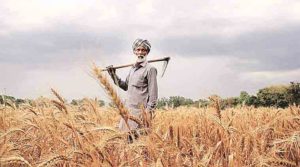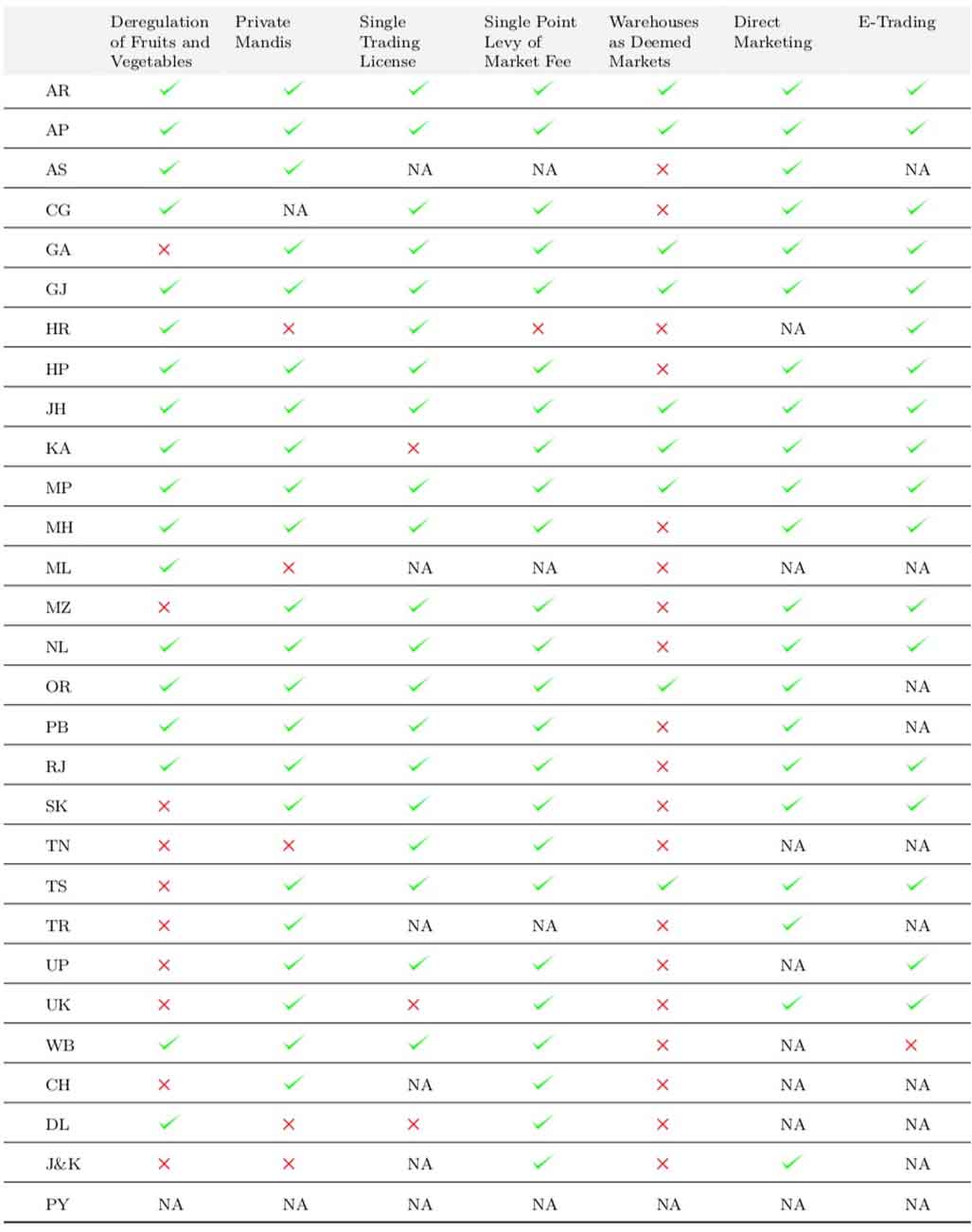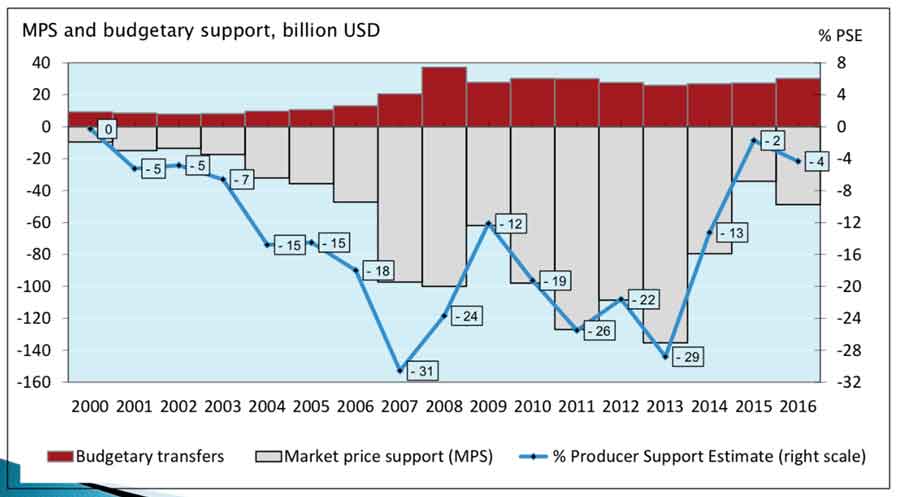As the farmers’ protests continue, Barun Mitra outlines some of the key issues that could help understand the current political deadlock over the three new farm laws, and suggests possible ways to reaching a wider consensus on agricultural reforms.

Indian agriculture is the largest private sector in the country; yet, it is the most regulated, restricted, and prohibited sector of the economy today. Despite such a handicap, Indian farmers have performed a near-miracle in transforming a situation of food scarcity to one of surplus. India has also emerged as a major exporter of agricultural produce, ranked 8th by WTO (World Trade Organization) in 2019. But this has been achieved at a high cost: today, half the population remains largely dependent on a shrinking share of agriculture, 15%, in gross domestic product (GDP).
The government says that the new farm laws will give freedom to the farmers to sell their produce to anyone, anywhere in the country. However, farmers have that freedom, since the 1990s. The government says contract farming will bring investment and knowledge, and improve incomes, but many farmers have been engaging in contracts of various kinds for many years.
In this post, I outline some key issues that could help understand the current political deadlock with the farmers over the three new farm laws, and possible ways to a more meaningful dialogue with the hope of building a wider consensus on agricultural reforms. Legitimacy of any legislation depends not just on the legislative majority, but equally on the acceptability of the process adopted as legitimate by those who may even disagree on the content of the proposed law.
Rebuilding trust and creating conducive environment for dialogue
First, the central government’s willingness to engage in a dialogue with farmers is a welcome step. However, such consultation should have been undertaken before promulgating the ordinances in June 2020, and subsequently rushing these through parliament in September, without the extensive, in-depth deliberation and debate that such laws warrant. For any meaningful discussion, mutual trust is paramount. Yet, the various attempts to divide the farming community in recent weeks on the basis of who supports and opposes the laws, is not conducive to having an open conversation on the complex issues confronting Indian agriculture.
Second, following rounds of discussions with protesting farmers, on 9 December 2020, the central government proposed a list of possible changes to the new farm laws, and to the Electricity Act (more on this later). The proposed changes in the key features1 of two of the three new farm laws suggest that the new laws in their current form may not really have been necessary at all.
Third, on 21 January 2021, the government offered to suspend the three laws for a period of 18 months – although this was rejected by the farmers.2 These laws being structural in nature, cannot be implemented overnight on the ground. States were already taking steps towards reforming agricultural markets over the past 15 years (Anand et al. 2020). Therefore, nothing will be lost if the government withdraws these laws. Such a decision is likely to go a long way in rebuilding mutual trust and creating a conducive environment for dialogue necessary for any broadly acceptable framework to emerge.
Centre versus states
Fourth, recognising the federal nature of the Indian Republic, the central government often proposes model acts to encourage the state governments to adopt or adapt, and to nudge the country towards a common goal. The NDA (National Democratic Alliance) government had prepared a model APMC (Agricultural Produce Marketing Committee), Act in 2003. Since then, 22 states have gradually reformed their APMC laws to allow private mandis (markets). Kerala never had any APMC, and Bihar abolished it in 2006. Also, 18 states have deregulated trade in fruits and vegetables (Table 1). In 2018, the NDA government prepared the model contract farming law. Both these model laws indicate that previous governments at the Centre had considered agriculture to be a state subject under the Constitution.
Table 1. Status of deregulation in agriculture, as of May 2020
 Source: Centre for Civil Society, 2020.
Source: Centre for Civil Society, 2020.
Fifth, agriculture by its very nature is a localised activity, and requires a decentralised approach. The new farm laws have been enacted through a novel interpretation of the Constitution, seeking to institute centralised control over agriculture marketing and production.3 Yet, among the dozens of official reports brought out in the past two decades on various aspects of agriculture reforms, there is not one that suggested this kind of Constitutional manoeuvres.
In the name of ‘one nation, one market’, the new laws are sanctioning two categories markets even within each state. This manoeuvre has undermined the decades-old understanding that agriculture is a constitutionally mandated subject primarily under the jurisdiction of the states. Therefore, the proposed amendments to the new farm laws will not be adequate unless the Constitutional basis is clarified. This has extremely serious implications for the federal structure of India and taxation powers4 of the states, which have been repeatedly upheld by the Supreme Court.
Sixth, centralisation always opens the door for future misuse by the central and state governments. The government of the day in 1951 had promised that not too many laws would need the protection of the Ninth Schedule;5 yet from the initial 13 laws, the list has grown to 284. Likewise, the sedition law was retained on the assurance that it would be very sparingly invoked in Independent India. Unfortunately, over the decades it has been increasingly invoked more liberally than during the colonial rule. Similarly, by now legitimising centralised control over agriculture, the prospect of farmers’ freedom may remain a promise that may not be realised in a long time. Liberalisation requires decentralisation and devolution of power, therefore ‘market reforms’ by centralisation of power is inherently a contradiction.
Seventh, the concerned parties and the state governments should approach the High Courts in the states, place the issues in their local context, and seek Constitutional redressal. The Supreme Court could advise the High Courts to expedite such hearings. Such an approach will allow the High Courts to hear the various context-specific aspects – legal as well as the practical impacts – of the new laws. As and when necessary, the Supreme Court could give a final ruling on the constitutionality of the laws, after considering the information and analysis provided by the lower courts.
Proposed changes to Electricity Act
Eighth, the proposed changes to the Electricity Act requires farmers to first pay their electricity bill, and then get part of it reimbursed from the state governments that have a policy of subsidising electricity used for agriculture. This may have significant and serious cash flow implications for farmers. The prospect of implementing DBT (direct benefit transfer) for such an electricity subsidy for farmers can be extremely complicated. For instance, a parcel of agriculture land may be held in a coparcenary, by a number of co-owners, or joint heirs but the electricity meter may be in the name of only one of them. Besides, the actual farming may be carried out by someone else, say in a tenant capacity. In the absence of a congruence of relationship between the landowner, electricity meter, and the farmer – or at least a system of recognising this complex web – operationalising DBT will be a herculean challenge. The current, informal arrangements among these stakeholders to share the electricity cost work precisely because the people know each other and their context and any move towards DBT may completely disrupt these working relationships, and sow doubts and mistrust.
Larger problem of formalising contract farming
Ninth, the problem with DBT for electricity subsidy represents the larger problem of formalising contract farming. It requires recognising and documenting the existing operational relationships that farmers, landowners, and other stakeholders often engage in. It is the absence of such recognition that many ‘real’ farmers (versus those who own land but do not farm) are routinely denied access to formal credit and many other government schemes such as Kisan Samman Nidhi.6 Reform of land ceiling and land-use regulations by state governments, together with updating records of land ownership and also information on the varied users, tenants, and other claimants to the land, may go a long way in helping formalise contracts. There is a need to recognise that contracts are a reflection of the prevailing economic conditions, legal framework, and efficacy of the judicial system to enforce contracts. The fact that 20-50% of agriculture is under some kind of contract, largely informal, is reflection of that reality.7 An additional layer in the form of the new contract farming law is unlikely to resolve the challenging ground realities. Once there is a credible effort to reform the factors responsible for the complexities involved, more contracts may get formalised, and then most of these could be easily governed under the existing Indian Contract Act, 1872 (which recognises formal, semi-formal, and informal contracts).
Hindering free trade in agricultural commodities
Tenth, one of the fundamental reasons that the government’s credibility was questioned was that on the very day the government was hailing the new farm laws for ushering in freedom for the farmers in parliament in mid-September, the government also invoked the Foreign Trade Act (FTA) to ban the export of onions with immediate effect. Such ad-hoc prohibition on onion export has become almost an annual feature, despite the fact that India produces almost 50% more onion than it consumes, and there is a perpetual shortage in quality storage facilities. Such interventions routinely infringe on the freedom to trade and negate the sanctity of contracts. The FTA, together with the Essential Commodities Act (ECA) have, for decades, hindered free trade in agriculture commodities within the country and made international trade uncertain.
Eleventh, the amendment to ECA is unconvincing, it removes specific agriculture items from its list, and lifts limits on stock holding. But it provides two umbrella clauses for government intervention on the grounds of economic and other emergencies. The ECA can be invoked in case of 50% increases in price of foodgrains, and 100% increase in price in case of perishables. These provisions raise the question whether the foodgrain storage capacities currently being built by certain companies will place them in privileged position. Foodgrains that are actually procured in bulk have not experienced wide fluctuations in prices due to surplus production in recent decades. So, they are unlikely to face the uncertainty of ECA being invoked against them, except for some lentils and oilseeds, where the domestic production is inadequate and prices have fluctuated very widely. This is in contrast with the situation in perishables, where the prices regularly fluctuate widely (100-300% in a season) and yet 30-40% of the produce is lost due to poor post-harvest facilities. Therefore, this criterion of 100% price rise for perishables will continue to undermine investor confidence, with the shadow of ECA over them. This is not conducive for developing such logistics where these are most needed, hence, perpetuating price volatility, and deprive farmers of better and predictable prices. The consumers too are losing out on a stable supply and price environment.
The MSP issue
Twelfth, given the way the new farm laws were crafted, it was rather predictable that the spotlight would fall on minimum support price (MSP) – despite the fact that the new laws do not mention MSP at all. MSP had played a key role in promoting the adoption of Green Revolution technologies and transformed a country characterised by food shortages to abundance of foodgrains. The APMC, MSP, procurement, and public distribution system (PDS) have over time become an integral part of the food economy. Together with open-ended procurement,8 it has cemented the relationship between APMC mandis and MSP, and hence any attempt to dilute the APMC mandis is inevitably seen as an assault on MSP and therefore, on procurement. Secondly, even with the limited price support and subsidies to agriculture, farmers in India have been under a burden of negative subsidy as Sharad Joshi – a farmer leader who founded Shetkari Sanghatana (farmers’ organisation) in 1979 – had originally pointed out in the 1980s.
Figure 1. ‘Implicit taxation’ of Indian agriculture
 That pattern has not changed much since then, as studies by others have pointed out. A 2018 study estimated that “India ‘implicitly taxes’ its agriculture…large input subsidies do not fully offset the effect of price-depressing policies”. Agricultural economist, Ashok Gulati, who led that study, writes in a recent article: “…between 2000-01 and 2016-17, Indian agriculture was implicitly taxed to the tune of almost 14% of its value. It was primarily due to restrictive trade and marketing policies, ranging from export controls to stocking limits to the restrictive mandi system in the country.” The potential problem of relying on MSP as a long-term strategy to boost production of rice and wheat, was recognised as early as the 1980s. There is a need to devise a smart and dynamic MSP programme that can help shift emphasis to crops where there is a shortfall in the country, for instance, lentils and oilseeds. Hardly anyone will deny the distortions caused by MSP, but the problem has built over decades, and will need to be creatively diffused over a period of time. That is the only way to ensure that the interests of both farmers and consumers are secured.
That pattern has not changed much since then, as studies by others have pointed out. A 2018 study estimated that “India ‘implicitly taxes’ its agriculture…large input subsidies do not fully offset the effect of price-depressing policies”. Agricultural economist, Ashok Gulati, who led that study, writes in a recent article: “…between 2000-01 and 2016-17, Indian agriculture was implicitly taxed to the tune of almost 14% of its value. It was primarily due to restrictive trade and marketing policies, ranging from export controls to stocking limits to the restrictive mandi system in the country.” The potential problem of relying on MSP as a long-term strategy to boost production of rice and wheat, was recognised as early as the 1980s. There is a need to devise a smart and dynamic MSP programme that can help shift emphasis to crops where there is a shortfall in the country, for instance, lentils and oilseeds. Hardly anyone will deny the distortions caused by MSP, but the problem has built over decades, and will need to be creatively diffused over a period of time. That is the only way to ensure that the interests of both farmers and consumers are secured.
Understanding the broader political and social context
Thirteenth, after the initial success of BT cotton, approved during 2002-2006, successive governments have dithered on genetically modified (GM) crops. Consequently, at least two new GM crops – GM mustard and brinjal – developed by Indian scientists have been waiting for final approval from the government, after clearing all the regulatory steps. In addition, there are four major GM crops that are currently being grown across the world in a major way. But Indian farmers have been denied access to new scientific developments for over a decade now. Thousands of cotton farmers have been risking their crops by sowing unapproved GM cotton for the last few years to press for their demand for new generation of crops. GM crops have the potential to reduce the ecological footprint and costs, and improve farmers’ income and competitiveness of Indian agriculture, particularly in cotton, maize, and soybean. But the core issue is not so much about any particular technology, but farmers’ freedom to choose the technology, be it natural farming, organic, genetic engineering, or anything else. Capacity to trade in a competitive world depends on the freedom to choose the relevant technologies.
Fourteenth, surveys have repeatedly shown that a large section of farmers want to quit or don’t want their children to take up agriculture. “On being asked whether they would leave farming if they get an employment opportunity in the city, 61% of the farmers answered in the affirmative”, finds the Centre for the Study of Developing Societies’ State of Indian Farmers, 2014. “When farmers were asked whether they want their children to settle in the city, as many as 60 per cent said they want their children to settle in the city.” But they have very few economic options in the non-agriculture sectors of the economy. Despite economic reforms and expansion of the manufacturing and service sectors, the employment potential has been low. The official data released in May 2019, showed that the unemployment rate had risen to a 45-year high of 6.1% in FY2017-18. Today, with the economy shrinking drastically after the lockdown in 2020, employment and economic prospects are hardly any brighter. In fact, indications are that a significant number of migrant workers who were forced to return home during the lockdown, may have gone back to farming, thereby increasing dependence on agriculture. Clearly, the roots of the challenge facing the farmers go far beyond agriculture itself.
Leverage consensus on agricultural crisis
In the heat and dust of the ongoing farmers’ agitation, it is easy to forget that there is almost a consensus on the scale and scope of the crisis in facing agriculture in India. For two decades, discussions have taken place on reforming agriculture market and contract farming. In the countless reports and documents produced, never had anyone suggested that national legislations could or should be crafted towards that. Instead there had been agreement that agriculture and land are both state subjects. That consensus needs to be leveraged to facilitate a wider and honest discussion on the direction of necessary reforms. Disparaging the ongoing debate and fuelling divisions within the farming community will only undercut the roots of much-needed reforms in agriculture. The current debate therefore is a huge opportunity towards a new consensus on incremental changes in agriculture at the state and local levels, which over the course of the next decade, could truly transform Indian agriculture as well as the wider economy. No country can prosper by forcing half the population to remain dependent on agriculture.
Notes:
- The proposed changes in the new laws on agriculture markets recognise the right of the states to tax the new private markets. In the new contract farming law, the government has offered to allow disputes regarding contracts to be brought before the judicial system.
- The offer was renewed by the Prime Minister at an all-party meeting on 31 January.
- The government has not provided an official explanation of the constitutional provisions it has invoked for the two new farm laws (regarding agricultural marketing and contract farming). After rushing the laws through parliament in mid-September 2020, the marketing division of the Ministry of Agriculture and Farmers Welfare, circulated a presentation. It shows that Entry 42 of the Union List in the Constitution, along with Entry 33 in the Concurrent list, dealing with interstate trade, have been invoked to override agriculture trade in Entry 26 of the State list.
- States have the responsibility of governing exclusively state-specific subjects specified in List II of the Seventh Schedule of the onstitution such as law and order, agriculture, fisheries, water supply and irrigation, school education, and public health. The states also have the power to tax agriculture income, alcohol, land and buildings, minerals, petroleum products, etc.
- The first amendment to the Constitution introduced the Ninth Schedule whereby the state and central governments could place certain laws giving them immunity from legal challenge on the ground of violation of fundamental rights. Over the years various state laws, including those pertaining to land ceiling and land distribution have been included. Then the Essential Commodities Act was added in 1976, two decades after it was originally enacted.
- Under the Kisan Samman Nidhi scheme an income support of Rs. 6,000 per year in three equal installments is provided to small and marginal farmer families having combined land holding/ownership of up to two hectares.
- The 20-50% range is my sense from talking to farmers in Bihar, Tamil Nadu, Maharashtra, Madhya Pradesh, Haryana, and Punjab.
- Open-ended procurement refers to the process whereby foodgrains are offered by farmers within a stipulated procurement period, and in accordance with quality specifications of Government of India; this is purchased at MSP by government agencies including Food Corporation of India for the central pool.
Courtesy : Barun Mitra (Independent Researcher).

